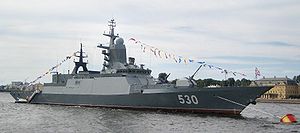 The corvette Steregushchiy
| |
| Class overview | |
|---|---|
| Name | Steregushchiy class |
| Builders | |
| Operators | |
| Preceded by | Grisha class |
| Succeeded by | Gremyashchiy class |
| Subclasses |
|
| Cost | US$120-150m (est. for Tigr) |
| Built | 2001–present |
| In commission | 2008–present |
| Planned | 12 (20380/81) |
| Building | 3 (20381) |
| Completed | 9 (20380/81) |
| Active | 9 (20380/81) |
| General characteristics | |
| Type | Guided missile corvette |
| Displacement |
|
| Length | 104.5 m (343 ft)[1] |
| Beam | |
| Draught | 3.7 m (12 ft)[1] |
| Installed power | 380/220 V AC, 50 Hz, 4x630 kW diesel genset |
| Propulsion | 2 shaft CODAD, 4 Kolomna 16D49 diesels 23,664 hp (17.6 MW)[1] |
| Speed | 27 kn (50 km/h; 31 mph)[1] |
| Range | 3,800 nmi (7,000 km; 4,400 mi) at 14 kn (26 km/h; 16 mph)[1] |
| Endurance | 15 days |
| Complement | 90 |
| Sensors and processing systems |
|
| Electronic warfare & decoys |
|
| Armament |
|
| Aircraft carried | |
The Steregushchiy class (Russian: Стерегущий, lit. 'Guarding'), Russian designation Project 20380, is a class of corvettes being built for the Russian Navy. Designed by the Almaz Central Marine Design Bureau, subsequent vessels were built to an improved design (Project 20381), incorporating the Zaslon-Redut SAM system. The ship full displacement and dimensions are large for a corvette, thus it is designated as a frigate by NATO.[1] The Steregushchiy class has been further developed into the Gremyashchiy class (Project 20385) and Project 20386 subclasses. The export variant is known as Project 20382 Tigr.
- ^ a b c d e f g h Henderson, Keith (13 October 2011). "Russian Corvette Steregushchiy". Maritime Propulsion. Archived from the original on 16 July 2016. Retrieved 29 December 2014.
- ^ Ramm, Alexey; Stepovoy, Bogdan (18 December 2018). "С "Орланом" на корме: корветы-невидимки получат ударные дроны" [With "Orlan" at the stern: stealth corvettes will receive shock drones]. Izvestia (in Russian). Archived from the original on 22 December 2018. Retrieved 22 December 2018.